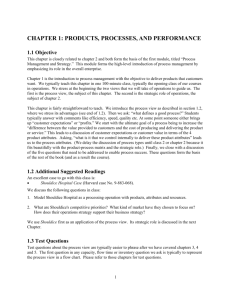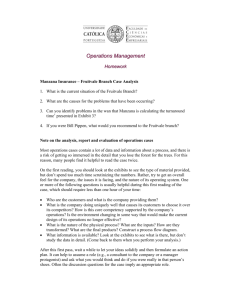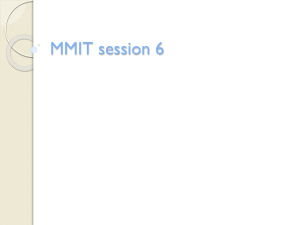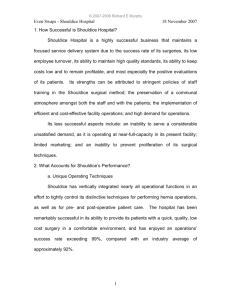operations management
advertisement
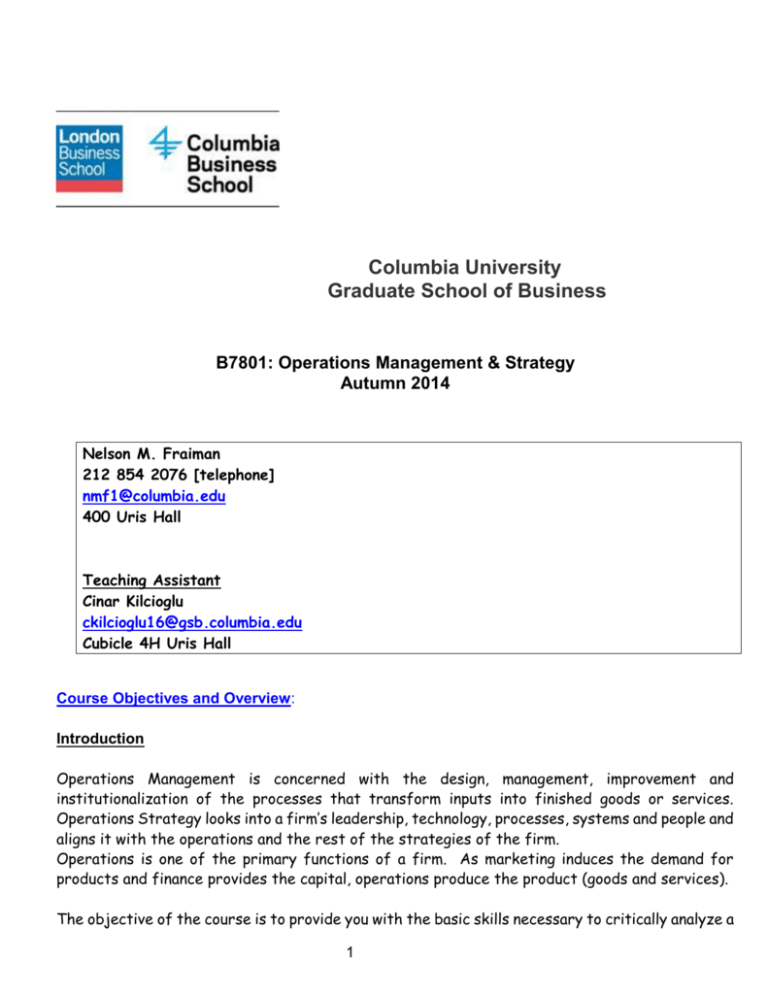
Columbia University Graduate School of Business B7801: Operations Management & Strategy Autumn 2014 Nelson M. Fraiman 212 854 2076 [telephone] nmf1@columbia.edu 400 Uris Hall Teaching Assistant Cinar Kilcioglu ckilcioglu16@gsb.columbia.edu Cubicle 4H Uris Hall Course Objectives and Overview: Introduction Operations Management is concerned with the design, management, improvement and institutionalization of the processes that transform inputs into finished goods or services. Operations Strategy looks into a firm’s leadership, technology, processes, systems and people and aligns it with the operations and the rest of the strategies of the firm. Operations is one of the primary functions of a firm. As marketing induces the demand for products and finance provides the capital, operations produce the product (goods and services). The objective of the course is to provide you with the basic skills necessary to critically analyze a 1 firm's operating performance and practices. Unlike many courses in the core, which tend to treat the firm as a "black box", we will be primarily concerned with "opening up" the black box and discovering what makes a firm "tick" - or, for that matter, "stop ticking". In contrast to your management courses, our focus is on the technological rather than human dimension of a firm's internal operations - though there are obvious connections between the two that we will explore. In contrast to the measurement focus of your accounting courses, our concern is understanding what elements of a firm's operations enable it to produce quality outputs at a competitive cost structure. That is, we will focus on how the "physics" of material, work and information flows and the design and management of a firm's processes interact to determine a firm's cost structure and its ability to compete effectively in terms of non-cost measures such as quality, variety and speed. The specific course objectives are to teach you to: Identify the operational capabilities needed to support a business strategy; Define and characterize key business processes; Establish a coherent operations strategy with clear performance objectives and process measures; Understand the impact of demand and process variability; and Use data and tools to evaluate and improve the efficiency and effectiveness of processes. Understand what makes a good operations strategy – what wins orders Consistent with a managerial perspective and approach, the application, rather than the derivation of models will be emphasized. The course thus strives to provide a balance between a qualitative approach and an analytical, applications-oriented, approach. In that spirit, both the strategic and the tactical dimensions of operations management will be addressed. Course Tools: Various educational approaches and learning tools will be utilized in the course. Conceptual readings and empirical studies in the form of journal articles and book chapters will provide the conceptual foundations and frameworks for dealing with the topics covered. Since the management of operations involves managing complex systems composed of people, equipment, materials, and information, there is rarely a single "best" solution for a problem. Thus we will be using case studies extensively to discuss the various dimensions of a problem and the trade-offs among alternative approaches in an attempt to reinforce the concepts learned through the reading materials and lecture notes. 2 Reading Material: Assigned material should be read before class to facilitate comprehension, discussion, and coverage. Many of the readings are short, and some you will be asked to merely skim through. Class Preparation: As indicated in the "Course Outline and Assignments" section of this syllabus, readings and case studies are assigned for most class sessions. The assigned material should be read before class to facilitate discussions and understanding of the material covered in class. Also, case studies are assigned for most class sessions. You should read the assigned cases thoroughly and more than once to get a full understanding of the situations and issues raised and the data included. In class, we will discuss the case assigned and analyze it as a group. Since class participation is a significant portion of your course grade, it is very important that you strive to be a vital contributor to such discussions. In an effort to encourage class participation, I will occasionally call on people and solicit contributions. The quality of your participation in discussions will be judged based on the content and depth of your comments, their relevance to the discussion, and your ability to move the class discussion forward. Executive Summaries and Case Statements: There will be a total of four group case assignments. Specific questions and issues to be addressed are listed in the syllabus. The executive summary should be prepared and written as a group effort and may consist of no more than two pages of double-spaced text plus 1-3 pages of attachments consisting of supporting analyses and exhibits. All assignments should be typed. However, attachments containing diagrams or quantitative analysis may be (neatly) done by hand. Additionally there will be four case individual assignments. You will be required to write a one to two paragraph description of the key problem and/or issue presented in the case. These are to be done on an individual basis. Assignments are due at the start of class, and late assignments will not be accepted. Midterm and Final Examinations The midterm examination will be closed book, closed notes, closed computer. You will be allowed one 8.5 x 11 sheet of paper with your notes. The final examination will take three hours and will be open book, open notes, open computer but no internet allowed. More details will be given before the exams. 3 Grading: Your grade in the course will be based on your individual as well as group efforts and performance. Your performance will be judged through a variety of mechanisms that will enable us to assess your understanding of the tools and concepts covered your ability to synthesize, integrate, and apply them, and your contributions to the class's learning experience. Thus, in determining your course grade, we will use the following grading scheme to help us judge your performance: Class Participation Case statements (Individual assignment) Shouldice Hospital Manzana Insurance NYPD Xenon Drives Executive Summaries (Group assignment) Beleza Natural National Cranberry Ritz Carlton Zara Midterm Examination Final Examination 4 20% 16% 24% 10% 30% COURSE OUTLINE AND ASSIGNMENTS Part I: Operations Strategy I & The Physics and Economics of Production Class 1 (Columbia Business School, Wednesday 17 September 2014, 13:00 – 16:00) Topic: Course introduction and overview. Operations strategy and business strategy. Plan: We will discuss the role of operations in the firm and the alignment that is necessary to be successful. Examples will be given to see the relationships between leadership/culture, processes, systems, technology and people. Based on your work experience, consider the following questions: What exactly are a firm’s operations? What do they entail? What techniques can be used to make a process efficient? What tradeoffs are involved? 5 Class 2 (Columbia Business School, Friday, 19 September 2014, 13:00 - !6:00) Topic: The process perspective Plan: Read Shouldice Hospital. For class discussion, prepare answers for the following questions: 1. Describe the Shouldice “production process.” What are the inputs, outputs, activities and resources? What are the major process steps? (A diagram may be helpful.) 2. From a purely technological/process standpoint, what is appealing about the way Shouldice Hospital operates its business? In particular, how does the service process enable them to achieve high efficiency and productivity? 3. How would you characterize Shouldice hospital’s operating strategy? Who is their target customer? What “product” do they provide? What competitive advantages do they have? How sustainable are they? Reading: Shouldice Hospital Limited Production Processes XTM Bike Due: Individual assignment: Shouldice Hospital. Answer question (3) above. 6 Review Session I: Saturday, 20 September 7:45 – 8:45 Class 3 (Columbia Business School, Saturday 20 September 2013, 13:00 – 16:00) Topics: Types of operating processes Bottleneck Analysis Process analysis Plan: Read Beleza Natural and be ready to answer the following questions: 1. What are the key elements of Beleza Natural’s business strategy? 2. How does the firm structure its processes to support the strategy? 3. Consider the Madureira Institute. Ignoring the evaluation step for new customers, draw the process flow diagram associated with the operations of the institute. Then calculate the following quantities for a Saturday: a. The capacity of each step b. Identify the bottleneck and the process capacity c. The utilization of each step? 4. What improvement measures would you suggest to increase the process efficiency and enhance the performance of the institute? Reading: Types of Processes Bottleneck Analysis Beleza Natural Due: Group assignment: Beleza Natural. Answer question (3) above. 7 Class 4 (London Business School, Wednesday, 8 October 2014, 9:00 – 12:00) Topics: Mass customization Plan: Read the National Cranberry Cooperative (NCC) case and answer the questions below in an executive summary. Attach a process flow diagram and supporting calculations to your report. 1. Draw a process flow diagram showing the major process steps, inventories and flows. Indicate the capacity at each of the process steps. You should assume: a. roughly 16,400 barrels of cranberries arrive at NCC on average per day over the 20 days from 9/20-10/9 (as shown in Exhibit 2 of the case) b. each truck carries 75 barrels on average and that trucks arrive uniformly over a 12hour period and c. trucks carry 70% wet berries and 30% dry berries. 2. Which operation (or operations) is the bottleneck? Note that both wet and dry berries can be run through the system at the same time. 3. How much overtime is required? 4. How bad is the truck delay? Estimate the time lost by drivers waiting to unload the trucks. 5. What are the basic options for improving the operation? Which options would you recommend and why? (Use data and analysis for supporting your recommendation.) Due: Group Assignment: NCC executive summary Reading: National Cranberry Cooperative (NCC) 8 Part II: Risk, Variability and Operations Excellence Review Session II: Wednesday, 9 October 7:45 – 8:45 Class 5 (London Business School, Thursday, 9 October 2014, 9:00 – 12:00) Topics: Response time and service system design Call center management The impact of demand and process variability; queuing models Plan: Read Manzana Insurance. Based on the case, answer the following question: 1. What is the bottleneck in Manzana's operations? (For your analysis, use the processing time data in Exhibits 4 and the request data for 1992 (6 months) in Exhibit 7). In addition we will talk about queuing models Due: Individual assignment: Manzana Insurance: Answer question (1) above. Reading: Queueing Management and Models Manzana Insurance 9 Class 6 (Columbia Business School, Wednesday, 5 November 2014, 9:00 – 12:00) Topics: Midterm Examination A case on patrol car allocation - NYPD Plan: What hypotheses can you suggest about the cause of Manzana's problems based on your analyses? What action(s) do you recommend to improve performance? Re-read Manzana Insurance. For class discussion, prepare answers for the following questions: 1. What problems is the Fruitvale Branch facing? Why have profits been deteriorating? 2. What are the important operational performance measures for Manzana? How are these tied to profitability? 3. What are your recommendations for managerial action? In particular, how should Manzana respond to Golden Gate’s new policy of one-day service? Also, Read the NYPD case and consider the following questions: 1. Assume there are 18 cars to allocate among the six precincts A,..,F given in the case exhibit. Determine an allocation of these 18 cars and discuss the basis for your allocation 2. What is your objective in making this decision? 3. Why did you choose this objective? Explain. The midterm examination will last 60 minutes. It will be closed book, closed notes. Internet access is not allowed. You will be allowed and 8.5 x 11 sheet of paper with your notes. Due: Individual assignment: NYPD. Answer question (1) above. Reading: New York City Police Department 10 Review Session III: Thursday, 6 November 7:45 – 8:45 Class 7 (Columbia Business School, Friday, 7 November 2014, 9:00 – 12:00) Topics: The role of quality: definitions, quality and costs, improving quality Statistical process control The magnificent seven Plan: We will consider the following issues: 1. What is statistical quality control and why is it important? 2. What is special and common cause variation? Why is it important to distinguish between the two? Reading: Statistical Process Control 11 Class 8 (Columbia Business School, Saturday 8 November 2014, 9:00 – 12:00) Topics: A case study of using data to achieve service excellence: Ritz-Carlton The Baldrige Award framework and 6. The Deming Cup. Plan: The Excel file ritz.xls contains a listing of a subset of all defects reported in the DQPR for the Ritz-Carlton Buckhead over the period from January 1997 to November 1997. The subset contains all defects for twelve categories of defects that directly impact the customer and are identified as causes for customer dissatisfaction. Analyze this data file and answer the following questions in an executive summary due at the start of class: 1. What is Ritz-Carlton’s business strategy, e.g. who are their primary customers? 2. How is quality defined at R-C? Does the data in the file ritz.xls indicate any significant quality problems? 3. If you were to select a category of defect to address from the DQPR data, which category would you address? Why? 4. For whatever defect category you selected, construct a p-chart to help identify days on which some “assignable cause” of added defects arose. 5. Using the results of your analysis and any other relevant tools of quality, as well as your common-sense knowledge of hotel operations, generate hypotheses about the possible root causes of the defect category that you selected. Due: Group Assignment: Ritz Carlton Hotel executive summary Answer questions 1, 2 and 3. Reading: Ritz Carlton Hotel Company 12 Part III: Supply Chain Management & Operations Strategy II Class 9 (London Business School, Tuesday 2 December 2014, 16:30 – 19:30) Topics: Quantitative tools for managing inventories We will continue with the discussion on Ritz Carlton and will answer questions 4 and 5. In addition we will focus on quantitative tools for managing inventories. Read the note and Xenon Drives and prepare the following for class discussion: 1. What problems is Xenon facing? 2. What are pipeline stocks, cycle stocks and safety stocks and what are these for Xenon? 3. What is fill rate? How is it defined? Why is this measure important? 4. What is the trade-off between fill rate and inventory levels? Due: Individual Assignment: Xenon Drives - Answer question (1) above. Reading: Xenon Drives Analyzing Inventory Cost and Service in Supply Chains 13 Class 10 (London Business School, Thursday, 4 December 2014 16:30 – 19:30) Topics: A case in high speed supply chain management: Zara Serving the bottom of the pyramid: Aravind Eye Hospital Plan: We will discuss Zara and Aravind Read Zara and answer the following questions in an executive summary due at the start of class: 1. What makes the Zara model successful? 2. Who do you think are Zara’s competitors? What advantages, if any, does it have over its competitors? 3. How far can Zara go with their manufacturing, distribution and retailing strategies? 4. Do you think marking price for multiple countries in a tag was a good idea? Why? Why not? Read Aravind Eye Hospital and be ready to discuss:: 1. Can you identify the key factors that have led to Aravind's success? What has Dr. V.'s role been in all this? 2. What has been the role of Aravind's clinical and support staff in all this? Are they dedicated and altruistic or do they have an ulterior motive? 3. How are the satellite hospitals at Tirunelveli (best labeled T-Valley) and Theni doing? 4. How do you evaluate the quality of service at the free hospital? At the paying hospital? 5. Are there any weaknesses at all with the Aravind model of delivering eye care? Due: Group Assignment: Zara Readings: Aravind Eye Hospital Zara 14 15
